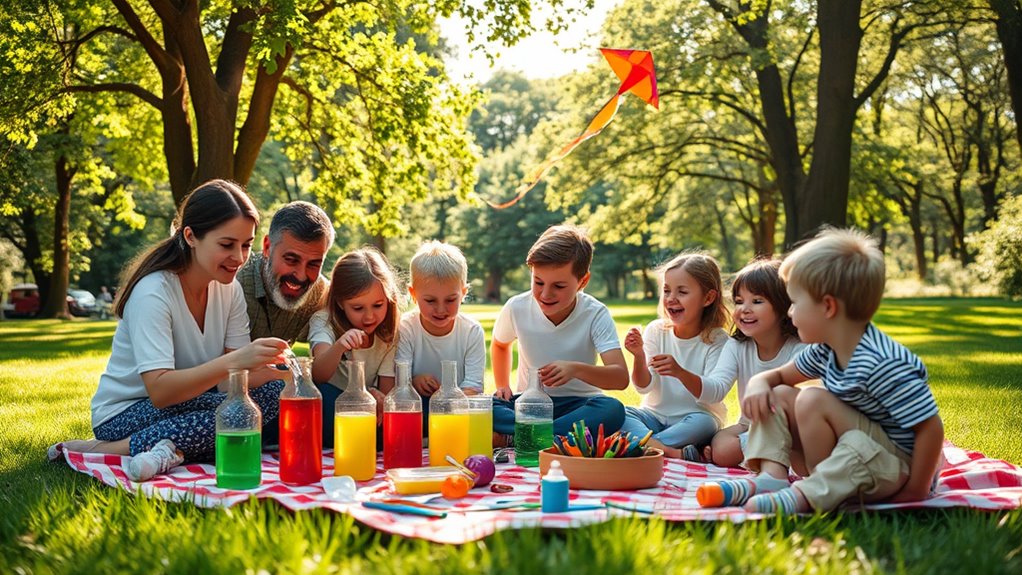10 Fun and Educational Activities to Do as a Family
If you’re looking for fun and educational activities to do as a family, there are plenty of options to choose from. You could host a family game night or embark on a thrilling nature scavenger hunt. Cooking together fosters teamwork, while DIY science experiments spark curiosity. Visiting a museum can ignite discussions, and starting a family book club encourages exploration of new stories. Gardening teaches responsibility, and engaging in community service creates a sense of purpose. Exploring family history connects you with your roots. Keep exploring to discover even more exciting ideas that you and your family can enjoy together!
Key Takeaways
- Organize a family game night with a mix of classic and modern games to promote bonding and strategic thinking.
- Cook together by planning meals and grocery shopping, enhancing teamwork and communication skills while creating delicious memories.
- Conduct nature scavenger hunts to foster curiosity and wildlife identification skills through exploration and photography.
- Visit local museums for interactive learning experiences that stimulate curiosity and critical thinking about science, history, and art.
- Engage in community service activities, such as food drives and park cleanups, to teach responsibility and foster connections with neighbors.
Family Game Night
Family game night is a fantastic way to bring everyone together for some fun and friendly competition. You can set up a cozy space with snacks, drinks, and a variety of games that cater to different interests.
Whether you’re into classic board games or modern card games, there’s something for everyone. To make the most of your time, consider some effective board game strategies. For instance, if you’re playing a strategy game, analyze your opponents’ moves, and think a few steps ahead.
You might also want to incorporate trivia night themes into your game night. Choose categories that spark interest—like pop culture, history, or science. This not only adds variety but also encourages everyone to learn something new. You can divide into teams, making it competitive and exciting.
Don’t forget to rotate who picks the game each week; it keeps things fresh and ensures everyone feels included.
With a little planning and enthusiasm, family game night can become a cherished tradition that strengthens your bond while creating lasting memories. So gather your family, choose your games, and let the fun begin!
Nature Scavenger Hunt
Exploration is a thrilling way to connect with nature, and a nature scavenger hunt can turn an ordinary day into an exciting adventure for everyone. You can create a list of items to find, like specific leaves, flowers, or even signs of wildlife, which encourages kids to engage with their surroundings.
As you embark on this hunt, you’ll not only foster a sense of curiosity but also teach your family valuable skills in wildlife identification.
Don’t forget to pack a camera or use your smartphones for nature photography! Encourage everyone to capture their findings, whether it’s a unique insect, colorful bird, or stunning landscape. This activity can spark discussions about different species and their habitats, making the experience educational as well as fun.
To make it even more interactive, you could assign points for each item found or create categories like “most colorful” or “most unusual.”
At the end of the hunt, gather to share photos and stories, creating lasting memories. A nature scavenger hunt is a fantastic way to bond as a family while appreciating the beauty and diversity of the natural world around you.
Cooking Together
After a day spent in nature, gathering treasures from a scavenger hunt, cooking together can be another enjoyable way to bond. You can start by involving everyone in meal planning. Let each family member suggest a dish they’d love to try, making it a fun discussion about flavors and ingredients. This not only boosts excitement but also teaches kids about making choices and balancing meals.
Once you’ve settled on a menu, it’s time to gather the ingredients. Head to the grocery store as a team, encouraging kids to help find items on the list.
While cooking, involve everyone in the process—chopping, stirring, and tasting. This hands-on experience fosters teamwork and communication skills.
Consider adding an element of creativity by engaging in recipe swapping. Challenge each other to come up with variations on your chosen dishes or even explore different cuisines. This could lead to discovering new family favorites and expanding everyone’s culinary repertoire.
Finally, enjoy the meal together, taking time to appreciate not just the food but the memories created during the cooking process. Cooking as a family isn’t just about food; it’s about connection, learning, and having fun together.
DIY Science Experiments
Five simple DIY science experiments can turn an ordinary afternoon into an exciting learning adventure.
For starters, why not create a volcano eruption? All you need is baking soda, vinegar, and food coloring. Mix the baking soda with a splash of food coloring in a cup, then pour in the vinegar. Watch as your homemade volcano erupts in a colorful display!
Next, try making homemade slime. Combine equal parts white glue and water in a bowl, then add a few drops of food coloring for fun. In another bowl, mix a teaspoon of borax with a cup of warm water. Slowly add this borax solution to your glue mixture while stirring. Before you know it, you’ve got a stretchy, squishy slime to play with!
For a third experiment, explore the magic of density by layering liquids like oil, water, and syrup in a clear glass. You’ll be amazed at how they form distinct layers.
Finally, create a homemade compass using a needle, a magnet, and a cork. Float the cork in water with the magnetized needle on top to find true north.
These experiments aren’t just fun; they’ll spark curiosity and learning in your family!
Visit a Museum
If you’re looking to continue your family’s learning adventure, visiting a museum can be a fantastic way to engage with science, history, and art. Museums offer a wealth of knowledge and experiences that can spark curiosity in both kids and adults. From ancient artifacts to modern art exhibits, there’s something for everyone.
You can explore interactive displays that make learning fun and hands-on. Many museums feature activities designed specifically for children, encouraging them to touch, play, and experiment. This interactive approach not only captivates their attention but also reinforces what they learn.
Consider planning your visit around special events or workshops. Some museums host family days with themed activities that can deepen your understanding of specific topics. Don’t hesitate to ask museum staff for recommendations on what to see based on your family’s interests.
As you wander through the halls, take the time to discuss the exhibits. Ask questions and share thoughts; it’ll enhance the experience and encourage critical thinking.
Crafting Projects
Crafting projects can be a wonderfully creative way to spend time together as a family. You can explore various techniques and materials, allowing everyone to express their artistic talents. One fun project is paper mache. Gather some old newspapers, flour, and water, and create fun shapes or sculptures.
It’s an excellent opportunity for teamwork, as everyone can take turns applying layers and watching their creation take form.
Another engaging activity is scrapbooking. This allows you to preserve family memories while adding a personal touch. Collect photos, ticket stubs, and other mementos, and let each family member contribute by designing their own pages.
You can pick a theme, like vacations or holidays, and enjoy reminiscing as you work together.
Don’t forget to set up a crafting space where everyone feels comfortable. Have plenty of supplies on hand, like scissors, glue, and colored paper, to keep creativity flowing.
The beauty of crafting is that it’s not just about the finished product; it’s about the laughter, stories, and bonding that happen along the way. Embrace the mess and enjoy the process!
Book Club for Kids
Starting a book club for kids can be an exciting way to foster a love for reading while encouraging social interaction. You can begin by involving your kids in the book selection process, allowing them to choose titles that spark their interest. This not only makes them more invested but also introduces a genre variety that keeps things fresh and engaging.
Set clear reading goals to keep everyone on track and motivated. For each meeting, you can focus on different elements of the story, such as character analysis or thematic discussions. Encourage your kids to share their thoughts on the characters’ motivations or the underlying themes, which helps develop critical thinking skills.
Additionally, dive into author exploration by discussing the background of the writers and how their experiences might influence their stories. This can open up fascinating conversations and inspire kids to appreciate literature on a deeper level.
Gardening as a Family
There’s something special about gardening as a family that can bring everyone closer together. It’s not just about digging in the dirt; it’s about teamwork, communication, and nurturing life. You can start by teaching your kids various planting techniques. Show them how to sow seeds, transplant seedlings, and even how to care for different plants. This hands-on experience fosters a sense of responsibility and achievement.
In addition to planting, garden maintenance is crucial. Get everyone involved in watering, weeding, and checking for pests. This teaches essential life skills while making the work feel less daunting. You can create a schedule so every family member knows their tasks, promoting accountability and cooperation.
As the garden grows, so will your family bond. You’ll share the excitement of watching your plants flourish and even enjoy the fruits of your labor together when it’s time to harvest.
Whether you’re planting vegetables or flowers, gardening can be a delightful way to connect, learn, and create lasting memories. So grab those gloves, roll up your sleeves, and enjoy some quality time in the garden!
Family History Research
Exploring your family’s history can be just as rewarding as tending to a garden. Just like nurturing plants, digging into genealogy research helps you uncover roots that give your family a sense of identity.
Start by gathering stories from relatives; oral histories can provide invaluable insights into your ancestors’ lives. Set aside time with your family to share these stories, recording them for future generations. You can create a family tree together, visually mapping out connections and relationships.
Online resources like ancestry websites make it easier than ever to trace lineage, and you can involve everyone in the search for records, photos, or documents. As you delve deeper, you might discover fascinating tales that can spark lively conversations.
Encourage your family to ask questions and explore various branches of your family tree. This activity not only strengthens familial bonds but also instills a sense of pride in your heritage.
Don’t forget to celebrate your findings! Whether it’s hosting a family gathering to share discoveries or creating a scrapbook, these moments will foster a deeper appreciation for your family’s story.
Dive into the past together; it’s an adventure worth taking!
Community Service Activities
Getting involved in community service activities can be a fulfilling way for families to bond while making a positive impact. One great option is participating in food drives. You can gather non-perishable food items together, sort them, and donate them to local food banks.
It’s a fantastic way for everyone to learn about the importance of helping those in need while spending quality time together.
Another rewarding activity is organizing or joining park cleanups. Grab some gloves, trash bags, and head to your local park as a family.
Not only will you be beautifying your community, but you’ll also instill a sense of responsibility and environmental awareness in your kids.
Both of these activities allow you to engage with your neighbors, meet new friends, and foster a sense of teamwork within your family.
Plus, you’ll all walk away with a sense of accomplishment and a deeper connection to your community.
Frequently Asked Questions
How Can We Encourage Kids to Participate in Family Activities?
To encourage kids’ participation, try incentivizing participation with rewards for completing activities. It’s also helpful to foster teamwork by involving them in planning and decision-making. This way, they’ll feel more invested and excited.
What Age-Appropriate Activities Can We Do With Toddlers?
You might think toddlers can’t engage in meaningful activities, but they can! Try toddler arts like finger painting or sensory play with sand and water. These activities spark creativity and support their development in fun ways.
How Do We Balance Fun and Education in Activities?
To balance fun and education, you can mix family game nights with outdoor adventures. Games build critical thinking, while exploring nature fosters curiosity. It’s all about creating joyful experiences that also enhance learning for everyone involved.
What Materials Do We Need for DIY Science Experiments?
Oh, you thought DIY science experiments required fancy lab equipment? Not quite! Just grab some science kits and everyday household items like vinegar, baking soda, and food coloring. You’ll be shocked at the fun you can create!
How Can We Make Family History Research More Engaging for Children?
To make family history research engaging for children, you can create interactive timelines and encourage family storytelling. This approach brings history to life, making it relatable and fun, while fostering a deeper connection to their heritage.





